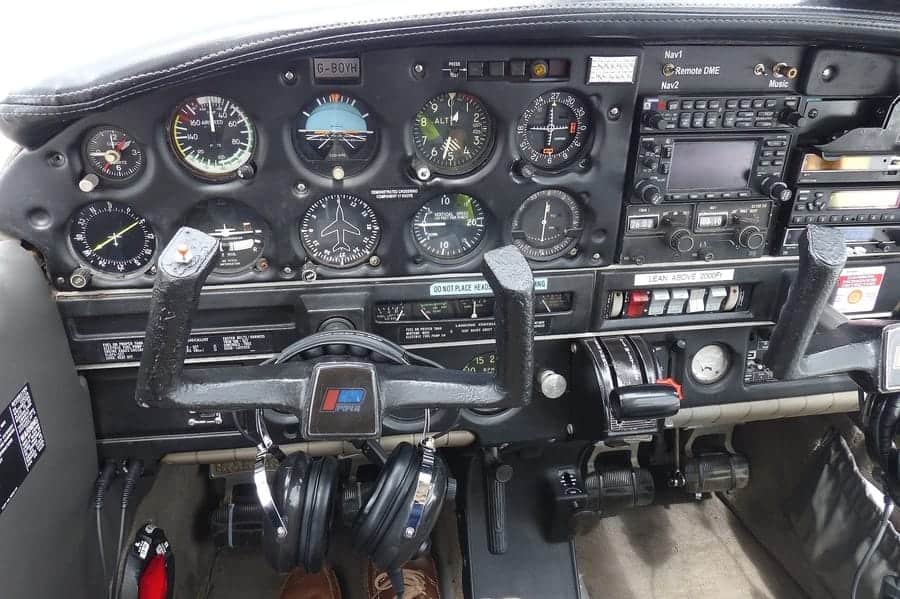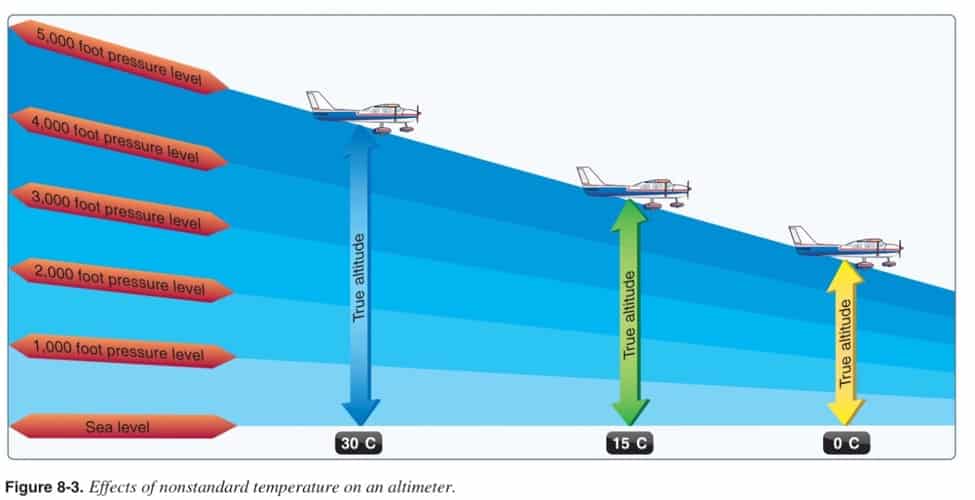
Standard pressure is 1013.25 hectopascals (hPa) which is equivalent to 29.92 inches of mercury (Hg). This setting is equivalent to the atmospheric pressure at mean sea level (MSL). Pressure altitude is primarily used in aircraft-performance calculations and in high-altitude flight. But why is 29.92 the “standard” altimeter setting?
At sea level, air pressure averages 29.92 inches of mercury. That means a glass tube with air completely pumped out and sealed at its upper end and placed in a dish of mercury at its lower (open) end would have mercury pushed up by air pressure to a height of 29.92 inches.
So 29.92 is an average at sea level. It’s a starting point. A standard. A basis for measurement to be read from. And this isn’t something that was invented or discovered yesterday. It has a bit of a history to it.
What’s a barometer exactly?
In aviation, we use altimeters to adjust for changes in pressure so that we don’t hit any terrain along our flight path and so that we also maintain accurate altitude spacing from other aircraft as the atmospheric pressure changes from area to area.
An altimeter is basically a pressure-sensitive barometer, but when were barometers invented?
In 1643 Evangelista Torricelli, an Italian physicist and mathematician, proved that he could weigh the atmosphere against a column of mercury. He measured pressure, converting it directly to weight.
The instrument Torricelli designed was the very first barometer.
The open end of a glass tube is placed in an open dish of mercury. Atmospheric pressure forces the mercury to rise up the tube. At sea level, the column of mercury will rise (on average) to a height of 29.92 inches or 760 millimeters.
Torricelli figured out that as you changed pressure, the level of mercury changed. This is important for figuring out trends in weather.
His theory was tested when Blaise Pascal (hectopascals) took a mercury tube up a mountain to show that the mercury level dropped as the atmospheric pressure decreased with altitude.

Image source: Pilots Handbook of Aeronautical Knowledge (PHAK) Chapter 4
Why not use water instead of mercury?
The reason is that at sea level, the water column would be about 34 feet high. Mercury on the other hand, is 14 times denser than water and is the heaviest substance available that remains a liquid at ordinary temperatures. That permits the instrument to be a more manageable size.
At the time, Torricelli didn’t know mercury was poisonous. We’ve since changed to aneroid barometers.
Inches of mercury is also useful in calculating things like manifold pressure. For more reading on this topic, see our article on why manifold pressure measured in inches of mercury.
What’s an aneroid barometer?
Invented in 1884 by French scientist Lucien Vidi, the aneroid barometer resembles a compass or clock.
Here’s how it works.
Inside of an aneroid barometer is a small flexible metal box. Since this box has had the air pumped out of it, small changes in external air pressure cause its metal to expand and contract.
The expansion and contraction movements drive mechanical levers inside which move a needle. A
s these movements drive the needle up or down around the barometer face dial, the pressure change is easily displayed.
This is exactly how your altimeter works. Inside the instrument is a set of sealed aneroid “wafers” that expands of contracts according to the pressure changes outside your airplane (measure from the static port). As your airplane climbs (less pressure) the wafers expand and show a higher altitude. The wafers collapse as you descend.

Image source: Pilots Handbook of Aeronautical Knowledge (PHAK) Chapter 8
Who sets the standard?
The International Civil Aviation Organization (ICAO) set 1013.25 hectopascals (hPa) as a worldwide standard, and it is often referred to as International Standard Atmosphere (ISA) or ICAO Standard Atmosphere.
The U.S. Standard Atmosphere, which uses 29.92”Hg is the same as the ICAO International Standard Atmosphere for altitudes up to 32 km, or 19.88 miles.
So 29.92 is the standard pressure, but what’s standard temperature?
Standard Temperature: 15oC or 59oF
The temperature of the atmosphere varies with time and location. Due to the changing atmosphere, a standard reference was developed by the ICAO.
The standard atmosphere (ISA) at sea level is a surface temperature of 15°C or 59°F.
The standard temperature and pressure can be found all over the world and no specific location is more prone to standard conditions over any other location. It all depends on the weather, whether you like it or not.
Any temperature or pressure that differs from the standard lapse rates is considered nonstandard temperature and pressure.
In aviation, any deviations from pressure and temperature effects how our instruments are calibrated and how the airplane performs. Let’s break it down.
Under Pressure
For pilots, pressure is not only an important variable in altitude but also important for determining how much oxygen is in the air.
The lower the pressure or the higher the altitude, the less oxygen there is in the air.
This has an influence on the air/fuel ratio used in engine tuning, the perfect ratio being 14:1 air-to-fuel ratio: for every one gram of fuel, 14 grams of air are required.
The pressure and temperature can change between takeoff and landing even on a local flight.
If these changes are not taken into consideration, flight becomes dangerous. According to the trusty Pilot’s Handbook of Aeronautical Knowledge (PHAK), if altimeters could not be adjusted for nonstandard pressure, a hazardous situation could occur.
For example, if an aircraft is flown from a high pressure area to a low pressure area without adjusting the altimeter, a constant altitude will be displayed, but the actual height of the aircraft above the ground would be lower than the indicated altitude.
There is an old aviation axiom: “GOING FROM A HIGH TO A LOW, LOOK OUT BELOW.”
Conversely, if an aircraft is flown from a low pressure area to a high pressure area without an adjustment of the altimeter, the actual altitude of the aircraft is higher than the indicated altitude.
Once in flight, it is important to frequently obtain current altimeter settings en route to ensure terrain and obstruction clearance. It’s also important to ensure that aircraft are properly separated from one another.
Many altimeters do not have an accurate means of being adjusted for barometric pressures in excess of 31.00 “Hg.
When the altimeter cannot be set to the higher pressure setting, the aircraft’s actual altitude is higher than the altimeter indicates. When low barometric pressure conditions occur (below 28.00), flight operations by aircraft unable to set the actual altimeter setting are not recommended.
And what’s the best way to get an updated altimeter setting? Ask ATC, obtain it from a nearby AWOS or simply ask other pilots on the radio what setting they are using.
How else is pressure important?
Pressure is also useful for determining pressure systems. A barometer value above 29.92”Hg is a high pressure system and usually means air is cooling, humidity is decreasing, and the pressure of that air is stabilizing the atmosphere.
A barometer reading below 29.92”Hg is a low pressure system and usually means air is warming and humidity is increasing. Low pressure systems tend to bring clouds, rain and snow storms. High pressure systems tend to bring clear skies and a calm atmosphere.
Why 29.92 above 18,000 feet?
Above 18,000 feet MSL pilots set the altimeter to the standard setting of 29.92 because they are clear of terrain and do not need to know their exact height above the ground. This reduces the load on air traffic control to not constantly provide updated altimeter settings to aircraft in cruise.
Temperature Affects Flight
Since cold air is denser than warm air, when operating in temperatures that are colder than standard, the altitude is lower than the altimeter indication (see figure below).
It is the magnitude of this “difference” that determines the magnitude of the error. It is the difference due to colder temperatures that concerns the pilot.
When flying into a cooler air mass while maintaining a constant indicated altitude, true altitude is lower.
If terrain or obstacle clearance is a factor in selecting a cruising altitude, particularly in mountainous terrain, remember to anticipate that a colder-than-standard temperature places the aircraft lower than the altimeter indicates.
Therefore, a higher indicated altitude may be required to provide adequate terrain clearance.
A variation of the memory aid used for pressure can be remembered as: “FROM HOT TO COLD, LOOK OUT BELOW.”
When the air is warmer than standard, the aircraft is higher than the altimeter indicates. Altitude corrections for temperature can be computed on the navigation computer or E6B.

Image source: Pilots Handbook of Aeronautical Knowledge (PHAK) Chapter 8
The science matters
Pilots can often get lost in the numbers, especially when they are frantically flight planning with an E6B the night before a checkride, but these numbers matter.
The tiresome calculations we do to determine performance, fuel burn and speed are crucial to ensuring a safe and fun flight to everyone on board.
So the next time you are flying around, make sure to get an updated altimeter setting and pay attention to the temperature when listening to the AWOS, these are big clues to various weather phenomenon.
As always: fly safe, be smart, and have fun.


